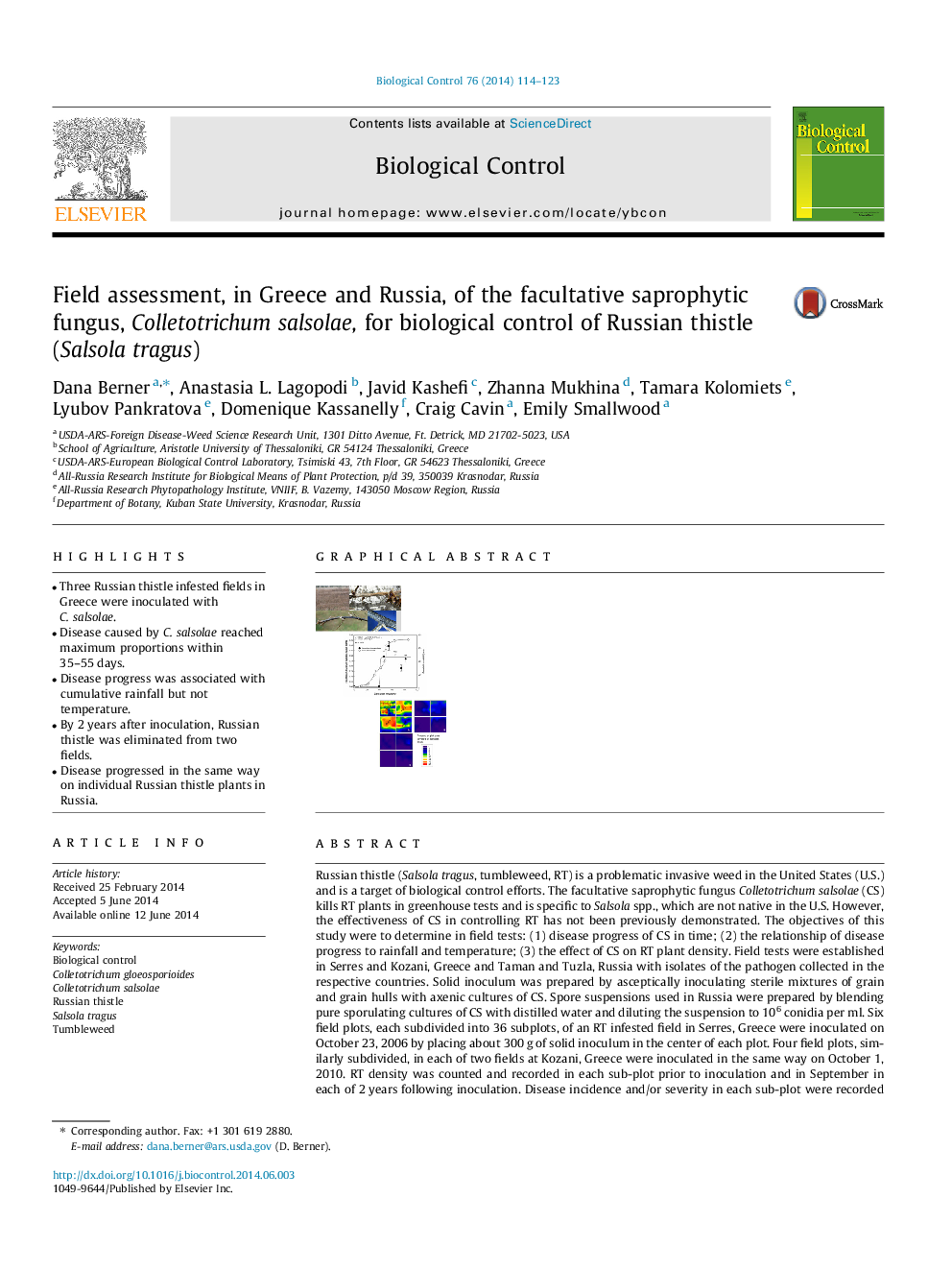| کد مقاله | کد نشریه | سال انتشار | مقاله انگلیسی | نسخه تمام متن |
|---|---|---|---|---|
| 4503892 | 1624258 | 2014 | 10 صفحه PDF | دانلود رایگان |

• Three Russian thistle infested fields in Greece were inoculated with C. salsolae.
• Disease caused by C. salsolae reached maximum proportions within 35–55 days.
• Disease progress was associated with cumulative rainfall but not temperature.
• By 2 years after inoculation, Russian thistle was eliminated from two fields.
• Disease progressed in the same way on individual Russian thistle plants in Russia.
Russian thistle (Salsola tragus, tumbleweed, RT) is a problematic invasive weed in the United States (U.S.) and is a target of biological control efforts. The facultative saprophytic fungus Colletotrichum salsolae (CS) kills RT plants in greenhouse tests and is specific to Salsola spp., which are not native in the U.S. However, the effectiveness of CS in controlling RT has not been previously demonstrated. The objectives of this study were to determine in field tests: (1) disease progress of CS in time; (2) the relationship of disease progress to rainfall and temperature; (3) the effect of CS on RT plant density. Field tests were established in Serres and Kozani, Greece and Taman and Tuzla, Russia with isolates of the pathogen collected in the respective countries. Solid inoculum was prepared by asceptically inoculating sterile mixtures of grain and grain hulls with axenic cultures of CS. Spore suspensions used in Russia were prepared by blending pure sporulating cultures of CS with distilled water and diluting the suspension to 106 conidia per ml. Six field plots, each subdivided into 36 subplots, of an RT infested field in Serres, Greece were inoculated on October 23, 2006 by placing about 300 g of solid inoculum in the center of each plot. Four field plots, similarly subdivided, in each of two fields at Kozani, Greece were inoculated in the same way on October 1, 2010. RT density was counted and recorded in each sub-plot prior to inoculation and in September in each of 2 years following inoculation. Disease incidence and/or severity in each sub-plot were recorded at about 7-days intervals after inoculation. Rainfall and temperature data, from inoculation until 40–55 days after inoculation, were collected and recorded at Serres and at the Kozani airport meteorological station. Disease progressed rapidly at both sites and was correlated with cumulative rainfall. By 2 years after inoculation, RT had been eliminated from the Serres site and one field in Kozani. In the other Kozani field, RT density declined to 0–25% from original densities of about 80% in large areas of the field. RT plants in Taman and Tuzla, Russia were inoculated either with 250 g of grain inoculum or with a suspension of 106 conidia sprayed onto each plant until runoff. The proportion of diseased tissue reached 1.0 by 55 days after inoculation in both sites. Non-inoculated plants that were near inoculated plants became diseased quickly and reached the same disease severity as inoculated plants. Disease severity was correlated with cumulative rainfall but not temperature. This pathogen and inoculation procedure offers a low-cost solution to RT infestations. Since CS is specific to Salsola spp., this effective biological control is also environmentally friendly.
Figure optionsDownload as PowerPoint slide
Journal: Biological Control - Volume 76, September 2014, Pages 114–123